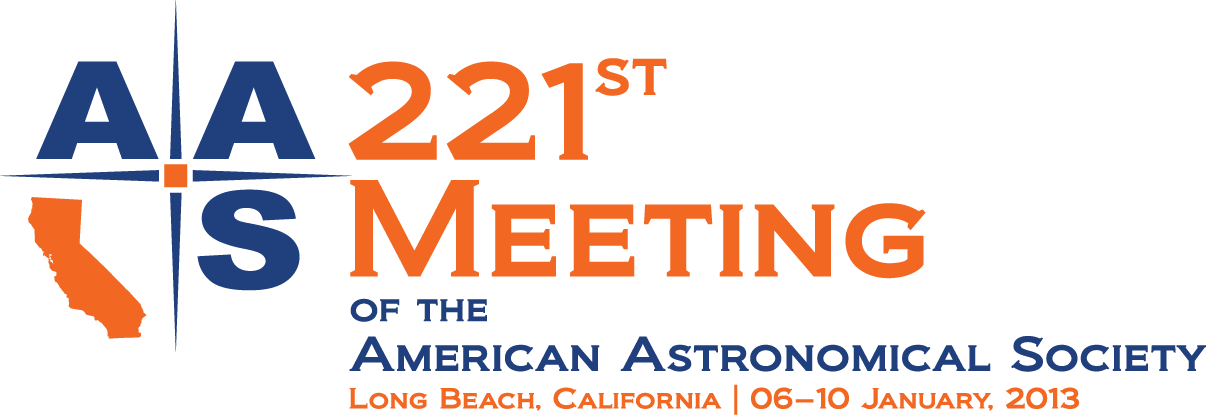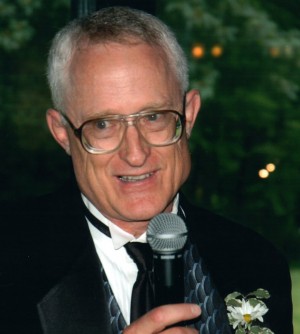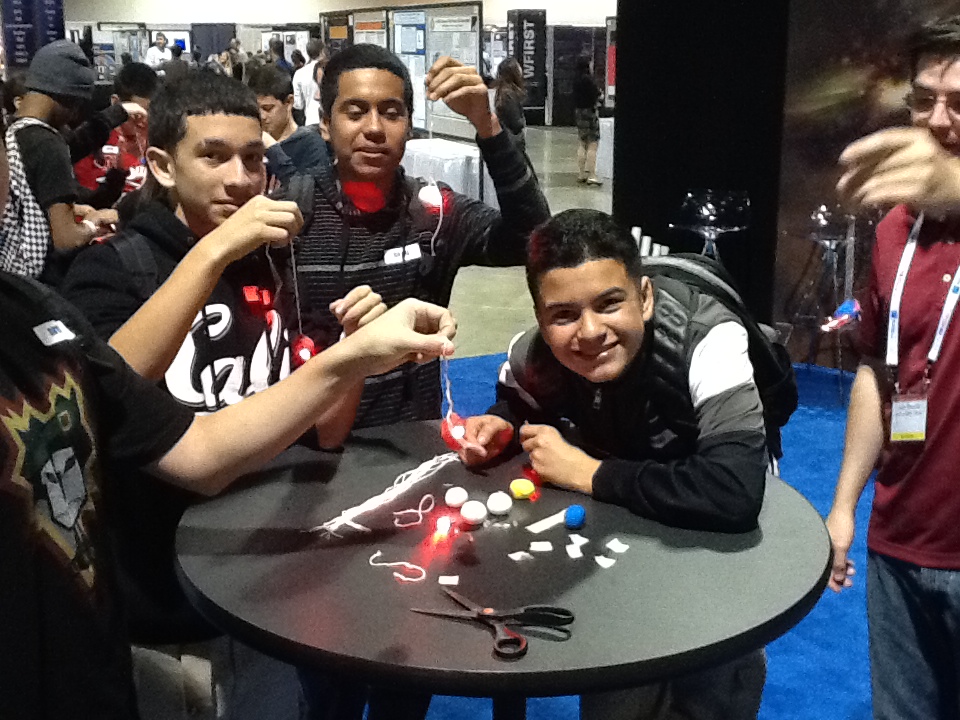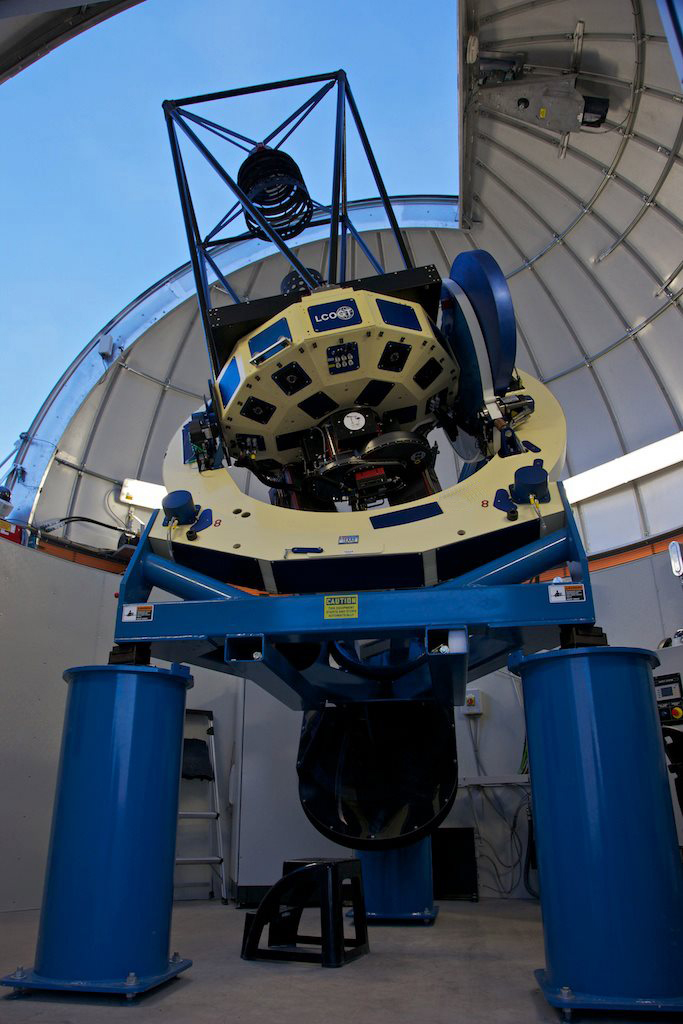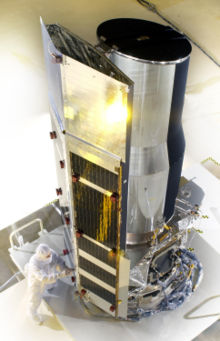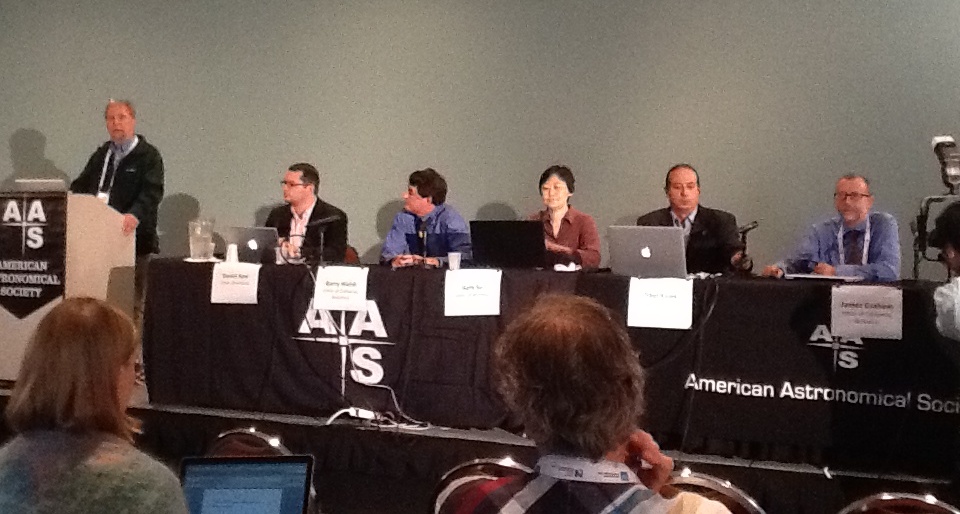User talk:Marshall
Robert's 221st AAS Scavenger Hunt – Jan 2013 NITARP Meeting
Overview:
Before ever having experienced an American Astronomical Society meeting I thought I was well versed in the astronomer’s culture. After taking numerous classes, doing hands-on labs, and having worked in the field of astronomy education for several years now I thought I knew what an astronomer did. When teaching courses I would tell students, “There are astronomers who just study stars, nothing else.” Well, this 221st meeting of the AAS has certainly been an eye opener. Yes, there are astronomers who just study stars but you must be more specific. How about: stellar rotation, protoplanetary disks (could be class 0, I, II, or III), or disk evolution, young stellar associations (OB, Open, possibly T), cluster structure? My experience has been one of culture shock. Astronomers, all of whom are scientists, can be personal, funny, and outright social beings. The nature of their work – retracing their steps for accuracy, being critical of fellow colleagues and looking to develop the next best project that has not been accomplished already – requires astronomers to discuss, inquire, and exchange eachother in their ideas. The AAS conference is a factory for knowledge and truth about the Universe. As David Helfand, president of the society said in his opening remarks, “We do astronomy because it defines us as human beings”. I’m now beginning to understand.
I would like to thank NASA, particularly the IPAC team at Caltech for their generous support and thirst to conduct public outreach through the NITARP program. Like the astronomers I described above, they too are very personal and simply genuine individuals. Without them I never would have had this distinct opportunity.
NITARP:
My experience began on Sunday January 5th when the NITARP team sat down together at the Long Beach convention center. The incoming 2013 team greeted one another and spent the entire day covering all bases of the program: purpose, evaluations, the year’s milestones and deadlines, what to expect from the program, an overview of the IPAC archives, the AAS conference itself, and how to read a scientific poster. Research teams split up and covered possible projects. My team, Dr. Rebull’s, picked ours based on previous NITARP research that had been accomplished. The thinking is an expansion of scientific discovery may lead to a possible research paper submission. Both 2012 and 2013 NITARP classes reconvened Monday evening for a forum where we discussed all aspects of the program. My research team’s final meeting was Tuesday late afternoon where we began to discuss the qualitative science behind our project: looking for Young Stellar Objects (YSOs) in the Bright Rimmed Cloud (BRC) 38 – located in Cepheus.
Educational Opportunities:
I attended several oral EPO sessions throughout the course of my stay in Long Beach. Astronomy Outreach for Non-Traditional Audiences (201) discussed how to bring astronomy directly to people who do not come to star parties. The session was chaired by Donald Lubowich who also did a talk on Music and Astronomy under the stars during a later EPO session. Culture change quoted as, “getting people to jump up and down about astronomy” was a common theme, April 2011 the Month of Astronomy was debriefed, and the concept of astronomy “hang-outs” or virtual star parties were unveiled. This video is awesome: ([1]).
I also attended the Effective Education & Public Outreach (302) session. Adler Planetarium gave a presentation using 3D glasses about stereoscopy for immersive planetarium content. They had conducted a study comparing over 80 different papers about 3D uses as an education tool ([2]). Jim Manning, from the Night Sky Network, later encouraged a culture of outreach in clubs. Lubowich recapped his Music and Astronomy Under the Stars program which has reached 50,000 people in just 4 years. I’ve received a lot of ideas from this program description. Finally, Globe at Night encouraging research on light pollution using the limiting magnitude charts which Carnegie Science Center ([3]) has done for the Pittsburgh area already.
There were several great posters geared toward the educational community, many of which came from NITARP teachers. Because of my team’s project I definitely took a look at the C-WAY poster titled Educating Teachers, Students, and Public on how you Discover Young Stars. But the poster I took most interest in was NITARP’s Identifying & Addressing Difficulties with Aperture, Wavelength, and Resolution in Education. It was very informative from not only my informal educator perspective but also scientifically. It reminded me of general concepts about optics that need to be engrained in my mind. There was a poster titled: Lighting the Fire for 25 Years by Donald McCarthy ([4]). Tuesday morning Donald was presented with the AAS Education Prize for his tireless efforts in reaching more than 1500 students, teachers, and adults in astronomy education – including a handful of youths who have now achieved their Ph.D.s in astronomy. He works at the University of Arizona as a research astronomer. His extracurricular activities remind me of the outreach work I do every summer at camp and how fruitful the reward can be.
In general, I found the exhibit hall to be a terrific source for educational concepts. Tuesday afternoon’s station activities were exceptionally fantastic for students and their teachers. I had a glimpse at some of the activities like using LEDs, clay, and string to make a spinning pulsar. This is just one idea I’ve walked away with from this conference that I can utilize at Carnegie Science Center.
The Exhibit Hall:
The exhibit hall contained mostly scientific posters and exhibitor booths. I had a chance to see several of Luisa’s posters: Effects of Stellar Rotation and Wind Clearing Around F Stars, another working with the YSOVAR team using Chandra and Spitzer data for a monitoring campaign as well as a study of the dark cloud L1228. Varoujan’s poster on a project which looked at both Spitzer and DIRBE data, from the COBE spacecraft, described the infrared background and was very well received by every scientist who stopped by. There was an interesting discussion about the calibration of Spitzer and WISE using Vega and Sirius. I saw the Enhancements to the Photometry Tool poster after I was given a tutorial on APT led by Russ at the IPAC booth. But now it turns out my team might not need to use this anyhow.
There were four actual scientific NITARP posters: SOFIA Observations of a Single Planetary Nebula, New Young Stellar Objects in BRC 27, Classification of Compact Submillimeter Sources in the Plank Archive, and Classification of Ultra Blue Sources in the Kepler Field. While I was browsing I also took a look through the Solar System section on Wednesday and found a poster on WISE/NEOWISE analysis comparing post-cryo and cryo data to determine post-cryo accuracy.
I was shocked at how many Earth based observatories were represented at booths. Next to Chandra there was the Submillimeter Array. In comparison with the JWST, in construction phase, there was a booth for the LSST, also under construction. I had a chance to stop by the Space Telescope Institute booth and talk with the Hubble folks and learn about the MAST database. Hoping there might be information our team could use I searched the Hubble Legacy Archive ([5]) for BRC38 and found a few images in the region. I also had the chance to talk to James Armstrong “JD” over at the Las Cumbres Observatory Global Telescope Network (LCOGT.net) booth. JD showed me on a map their global coverage since Luisa had mentioned potentially asking them for optical data in the future if we needed some. JD also amazed me with their tools like Star in a Box for stellar evolution education as well as Agent Exoplanet – an arcieve to allow the public to participate in looking at real LCOGT data ([6]).
I had a discussion with a programmer at the Virtual Astronomical Observatory (VAO) booth. I received a tutorial on professional SED modeling tools and was given links to quality educational applications like VAO workshops for educators ([7]) as well as the EuroVO-AIDA/WP5 software – a project developed to support the educational community approach to astronomy research. There are cool labs at the bottom of the webpage: ([8]).
The Oral Sessions:
Because my team will focus our project on looking for Young Stellar Objects (YSOs) I attempted to obtain as much information about these objects as possible. I went to two Circumstellar Disks (104 & 220) sessions. These talks included earliest stages of planet formation (dust to planetesimals), classical to transition disks, and evolution of protoplanetary disks in binary systems which included very cool 3D simulations. I was shocked when a member of the audience, during questions, told the speaker that he was flat out wrong about one assumption saying that indeed cm sized objects have been known to form clumping. I also attended YSOs, Very Young Stars, T-Tauri Stars, H-H Objects – Disks (117 & 137) sessions about spatial structure of YSOs and structure of class 1 protostellar disks which are not optically visible so the mass is difficult to know. But with the assistance of a submillimeter array plus SED info for resolution, computer modeling can begin to look for keplarian trends. John Tobin from NRAO resolved a disk around a specific class 0 protostar using Carbon monoxide with “no other molecules up his sleeves.” I also learned how an interferometer can be used to model the rotation of a star within a protoplanetary disk. Finally, within my field, I attended a Star Formation (312) session which disclosed the plotting of magnetic field alignments with the inner envelope of low-mass cores as well as looking at the formation and dynamics of infrared dark clouds.
There was time to sit in on lectures that fell outside of my field of study. Though not entirely off topic I went to Monday morning’s plenary talk by Soifer from SSC/Caltech discussing the science return and impact of the Spitzer Space telescope since its commissioning. Spitzer has 7,500 hours of observations. Because it’s in space above the atmosphere the 1m aperture becomes equivalent to a 30m aperture on Earth. Spitzer has discovered 500 protostars in Orion with evolutionary classes ranging 0 to III. I also learned that half the energy of all galaxies has been emitted in the infrared. This emission is called the cosmic infrared background. Spitzer is paving the way for future studies of JWST data.
I also listened to a plenary talk by Mordeci-Mark Mac Low from the American Museum of Natural History – From Gas to Dust Over Cosmic Time. Mordeci discussed how star formation in Large Magellanic Cloud sized galaxies dominates all epochs of the Universe and the effect of turbulence: it can promote star formation but overwhelmingly hinders it.
The final plenary talk I heard was by Natalie Batalha from the Kepler team & NASA Ames Research Center titled Finding the Next Earth. She described 58 candidates as being in the habitable zone of their host stars. One of these candidates is in its habitable zone of a sun-like star. But because this transient planet hunting method only finds maybe 1% of all planets we have to estimate a total for the Milky Way Galaxy. It has been estimated that 1 in 6 stars have an Earth-sized planet with an orbital radius of less then or equal to 85 days.
Before the end of my time I wanted to make sure I experienced a historical oral session. I caught the end of History of Astronomy (208) when Ian Steer from NED (the same gentleman who showed me the “bubbles” at the IPAC booth) was asking the question “Who really discovered Hubble’s Law?” He used an analogy of the CMB – how the CMB’s theoretical parents were not credited with the actual discovery.
The 2:30PM press conference on Tuesday titled Exoplanets from Dust Grains to Brown Dwarfs announced four new discoveries: the discovery of an asteroid belt around the star Vega, the measured wind velocities on a brown daft, an exocomet (as apposed to an exoplanet) as well as the measured orbital path of Fomalhaut b.
Finally, I had the opportunity to attend the NASA town hall on the Kepler Mission led by Steve Howell who is also a member of the NITARP group. “All people, all science” was his motto hoping to engage the public in Kepler’s extended missions after 4th year of operation.
